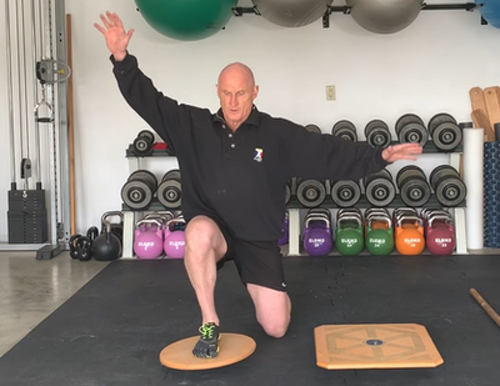The Unstable Lunge
 Happy Tuesday everyone!
Happy Tuesday everyone!
Have you suffered an injury to your anterior cruciate ligament (ACL), posterior cruciate ligament (PCL) or a torn meniscus? If you watch football or soccer, you see them ALL THE TIME!
So, how do you avoid them, especially if you’re playing a sport that forces you to change direction a lot?
In my latest blog/vlog, I explain how to incorporate the unstable lunge as an end exercise before you do your core exercises, two or three times each month.
(If you’ve already suffered an ACL, PCL or meniscus injury and want to avoid surgery, look for a skilled CHEK Professional in your part of the world, physical therapist or rehab expert to design a specific program for you.)
By creating an unstable environment with this exercise, your body receives lots of proprioceptive information about where you’re at in space.
This causes the hamstrings and calf muscles behind the knee and the quads in front of the knee to contract in order to stabilize the knee.
This process “trains” the brain to activate the muscles to stabilize the knee. Then, by doing it dynamically with a lunge (a common pattern), the brain can learn how to stabilize while moving.
For this vlog, I’m using a rocker board and wobble board I originally bought from Fitter, and which we also sell at the CHEK Institute.
If you’re using a rocker board, start by placing your left foot on the rocker board and practice lunging forward while bending your right knee downward behind you, while doing your best not to let the board touch the floor. It may be difficult for some of you to keep the board from moving around a lot, but do your best.

Be sure to keep breathing! Inhale to activate your core just enough to promote a sense of stability and lower your body, then take another breath when you get to the top of the movement. You could also do it on the fly depending on how much of a load your body is experiencing.
If you feel like it’s so hard that your breathing is locking up, take a deep breath and activate your core so you’ve got some core stability as you lower yourself down.
Then, as you pass the sticking point, breathe out through pursed lips to maintain the pressure in your core.
Once you’ve mastered this movement with your own body weight (with three sets ranging from 12-30 reps apiece), you could add dumbbells but that won’t increase the neurological complexity for you as much as moving to a wobble board.
When you move to the wobble board, start at the lowest level. You’ll see that it’s a lot harder to keep that board from touching the ground.

You’ve got to focus much more so that makes your brain and nervous system fire up nicely, plus your balance systems are getting a lot of training too. Behind the scenes, your brain is figuring out how to stabilize your knee with all of that dynamic activity. As you practice and get better at it, you can start rocking harder and moving more.
Want to make this exercise harder? Later on in my vlog, I’ll show you how a standard wooden dowel rod you typically use to hang clothes in a closet can also promote stability. It sounds simple but it’s can be really hard to do.
Just starting out, try it on a carpeted floor to prevent the rod from moving around too much. You’ll need to be ready when the rod moves to catch your balance because it really wants to move!

An effective rehab program doesn’t require a lot of expensive equipment. You can do it in a lot of different ways, even using a rock the size of a volleyball.
Once you’ve got the concept down, make sure you don’t make it so tricky that you could hurt yourself which defeats the entire purpose. Build up slowly and progressively.
If you want to learn more about core stability, I highly recommend my Scientific Core Conditioning and Scientific Back Training programs. They are bookends that will explain a lot of assessments and explore concepts on kinesiology and biomechanics.
And, if that’s not enough for you, consider taking CHEK Exercise Coach, our foundational corrective holistic exercise kinesiology training program.
More Dr. Movement is on the way next week… See you then!
Love and chi,
Paul